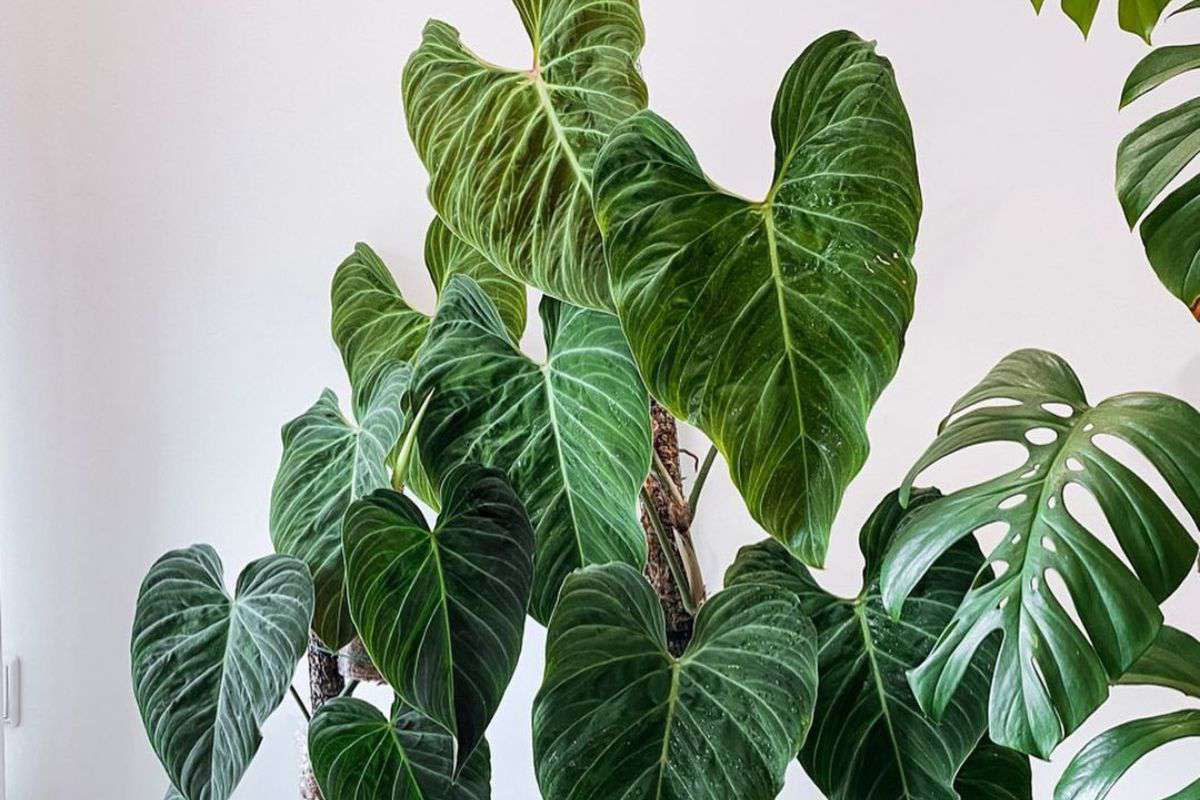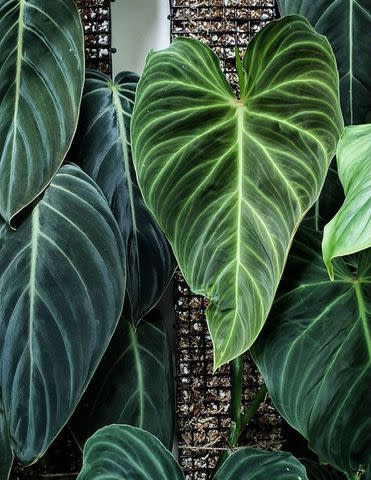How to Grow and Care for Philodendron Splendid, If You Can Get Your Hands on One

@felmiirwan / Instagram
Philodendron splendid (Philodendron melanochrysum x verrucosum) is a gorgeous hybrid philodendron that has become popular thanks to its large velvet leaves and striking white veining. This rare aroid is best suited for intermediate growers as it requires elevated humidity and a bit of extra care.
Just like its parents the P. melanochrysum and P. verrucosum, philodendron splendid is a climbing plant that reaches its full potential when given a moss pole or trellis to climb. While this plant could technically be grown outdoors in climates with consistently warm temperatures, it is mostly grown as a houseplant so that its conditions can be closely controlled.
Growers should be aware that like all plants in the aroid family, this philodendron is considered toxic to pets and humans if ingested.
Here’s everything you need to know about how to grow and care for the striking philodendron splendid.
Common Name | Philodendron splendid |
Botanical Name | Philodendron melanochrysum x verrucosum |
Family | Araceae |
Plant Type | Perennial |
Mature Size | 6-8 ft. tall, 2-3 ft wide (indoors) |
Sun Exposure | Partial |
Soil Type | Moist but well-draining |
Soil pH | Acidic |
Bloom Time | Spring, summer |
Flower Color | Green, white |
Hardiness Zones | 9-11, USDA |
Native Area | Cultivar, no native range |
Toxicity | Toxic to pets, toxic to humans |
Philodendron Splendid Care
Here are the basic requirements for growing philodendron splendid:
Provide the plant with several hours of bright, indirect light.
Allow the soil to partially dry between waterings.
Keep humidity between 60% to 70%.
Give the plant a moss pole or trellis to climb as it matures.

@kateandfinn_vs_plants / Instagram
Light
Bright indirect sunlight is best for this tropical plant. An east or northeast-facing window is ideal or set a few feet back from a west or south-facing window.
Avoid prolonged periods of harsh, direct sunlight where possible as the splendid’s delicate leaves are prone to leaf burn. That being said, brief periods of morning or evening sunlight should be fine. This philodendron can survive in low light but its growth will become slow and leggy and its leaves are prone to losing their luster.
Soil
As with most aroids, the right soil is key to preventing watering issues and helping the plant thrive indoors. Your soil mix should be airy and well-draining, yet rich with organic content. A combination of a good potting soil or coco coir, perlite, and orchid bark is ideal and easy to make at home. Commercial soil mixes designed for aroids are also a great choice.
Water
Allow the soil to dry about 50 percent between waterings. This philodendron is sensitive to overwatering and root rot, so as a general rule, it’s always better to underwater it than to overwater it. Ensure that your pot has drainage holes so that any extra water can drain from the plant’s roots, and then water thoroughly during each watering, fully saturating the soil. This is usually best done over a sink or drainage tray so that you can catch the extra water.
Temperature and Humidity
Philodendron splendid makes an ideal houseplant because it enjoys warm temperatures and average to high humidity levels. This plant is not frost-tolerant and should never be exposed to temperatures below 55 degrees Fahrenheit (13 degrees Celsius). It does best in temperatures between 65 to 90 degrees Fahrenheit (18 to 32 degrees Celsius).
This tropical hybrid also enjoys above-average humidity, although it will survive in standard household humidity levels too. If you want the plant’s growth to explode, some added humidity will do the trick. As a general rule, keep the humidity above 60% where possible, but under 80% to prevent fungal infections on the leaves. This makes indoor greenhouses or greenhouse cabinets ideal locations for these plants where humidity can be closely controlled.
Fertilizer
This houseplant should be fertilized regularly throughout spring and summer when it is actively growing, but not in fall and winter. Use a balanced liquid fertilizer diluted to half strength once a month, or a slow release fertilizer to given your plant an extra boost during its active growing period. Once temperatures outside begin to drop in the fall, stop fertilizing entirely until the following spring.
Propagating Philodendron Splendid
Just like many philodendrons, the philodendron splendid can be easily propagated by stem cuttings. This is a great way to grow new plants to share with friends or reuse plant cuttings if you decide to give your tall plant a trim. While this plant can be propagated at any time of the year, the best time to attempt propagation is in the spring and summer months when the plant is actively growing.
Follow these simple steps to propagate a philodendron splendid.
Using a pair of sharp, clean pruning shears; take a stem cutting from a healthy philodendron splendid plant. The cutting should have at least three nodes along the stem (but no more than five) and at least one leaf for the best chance of success.
Remove the bottom couple of leaves from the cutting, leaving at least one leaf at the top. This will expose the bottom nodes along the stem.
Prepare a small glass or plastic container with your choice of propagating medium. Water, sphagnum moss, or perlite are the three most popular options. While each may have its benefits, the choice is ultimately a personal preference. If you choose sphagnum moss or perlite, both should be soaked in water before placing the cutting in them
Place the cutting in the container, ensuring that the propagating medium (water, sphagnum moss, or perlite) covers the exposed nodes along the stem. Leaves at the top of the cutting should sit above the surface.
Place the cutting in a warm, humid location that receives indirect light. Roots should begin to sprout within a few weeks. Ensure that sphagnum moss and perlite are kept moist at all times, and water is refreshed once a week.
Once the roots are about an inch long the cutting can be planted in soil. Prepare a small pot with an airy, rich potting mix and plant the cutting, watering well after planting.
Return the freshly planted cutting to its original location and keep the soil evenly moist for the first couple of weeks to help the roots acclimate. Then, slowly cut back on watering until you have achieved a normal watering schedule (allowing the soil to dry 50 percent between waterings).
Potting and Repotting Philodendron Splendid
Philodendron splendid should be repotted once it has outgrown its previous potting container—approximately once every one to two years, depending on its growth rate. Repotting not only helps give the roots more space but also allows you to refresh the potting soil and provide your plant with plenty of new nutrients. Repotting is best done in the spring when the plant is actively growing.
Follow these steps to repot a philodendron splendid.
Choose a new pot that is only two to four inches larger in diameter than the previous potting container. Ensure the new pot has drainage holes to help prevent root rot.
Remove your plant from its existing container and remove as much of the old soil from the roots as you can, being cautious to break as few as possible.
Fill the bottom of the new pot with a fresh, well-draining soil mix and plant the root ball of your Philodendron splendid inside, so it’s sitting about one-third of the way down in the pot with plenty of room to place fresh soil on top of it.
Fill in the rest of the pot with new soil, patting down firmly around the stem of the plant.
Water the freshly repotted plant thoroughly, allowing the excess to drain from the pot’s drainage holes.
Return the plant to its original location and resume a regular watering schedule. Wait a month or so before fertilizing your plant again so you don’t burn any roots that were broken during the repotting process.
Common Pests and Plant Diseases
Keep an eye out for common houseplant pests like spider mites, fungus gnats, mealybugs, and scale. If you notice pests on your plant, isolate it immediately from any other houseplants in your home and treat it with neem oil or an insecticide until the infestation is gone.
As for diseases, root rot and fungal leaf spot diseases are the main ones to watch out for on a philodendron splendid. Root rot is usually due to overwatering problems or a lack of soil drainage, while fungal leaf spot diseases are a common problem among philodendrons in general. Luckily, both can be remediated if they are caught early enough.
Common Problems With Philodendron Splendid
For the most part, caring for a philodendron splendid is relatively straightforward, especially if you have some aroid experience under your belt. However, it’s normal to run into a few common problems along the way, particularly right after you bring your plant home (the acclimation period) and as you learn how to care for this tropical plant. Brown spots on the leaves and leaves turning yellow are two common problems to watch out for.
Brown Spots on Leaves
There are several reasons that a philodendron splendid may develop brown spots on its leaves. Small, rust-colored brown spots are usually a sign of a fungal leaf spot disease which needs to be treated with a fungicide. Larger brown spots that are crispy are often an indication of leaf burn, or a lack of humidity. If the entire leaf is browning and falling off, this can be a sign that your plant is underwatered, or not receiving enough light.
Yellow Leaves
Yellow leaves are a common problem with most plants and the philodendron splendid is no exception. Usually, it’s due to a lack of light or a lack of water, but it can also be a sign of pests, too much water, too much light, or a lack of humidity. Ultimately, you’ll have to examine your plant’s growing environment to figure out what the root cause may be.
Frequently Asked Questions
Is philodendron splendid rare?
This hybrid philodendron is considered rare and relatively difficult to find. You likely won’t stumble across this plant at your local big box store. If you’re looking to get your hands on a philodendron splendid then specialty houseplant shops, houseplant collectors, and online sellers are the best places to check.
What is the difference between philodendron gloriosum and splendid?
At first glance, Philodendron gloriusum and splendid may look similar, with their large velvety leaves and white veining. However, besides being two unique species of plants, there are a few key differences that set these two apart. First, the gloriosum is a terrestrial plant—meaning it grows along the ground—while the splendid is a climbing philodendron. Second, the gloriosum’s leaves are relatively wide and short, while the splendid’s leaves are narrower and longer.
What is the difference between the philodendron splendid and glorious?
Philodendron glorious is a hybrid between P. gloriosum and P. melanochrysum, and looks very similar to the Philodendron splendid thanks to the influence of P. melanochrysum in both plants. However, a few small differences can help you tell these two rare philodendronss apart. The philodendron splendid has more pronounced veins than the philodendron glorious, and the philodendron glorious has slightly more heart-shaped leaves when compared to the elongated shape of the philodendron splendid.
Read Next: 25 Types of Philodendron to Grow Indoors
Read the original article on The Spruce.

